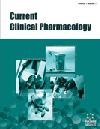- Home
- A-Z Publications
- Current Clinical Pharmacology
- Previous Issues
- Volume 4, Issue 2, 2009
Current Clinical Pharmacology - Volume 4, Issue 2, 2009
Volume 4, Issue 2, 2009
-
-
Is Propofol the Perfect Hypnotic Agent for Procedural Sedation in Neonates?
More LessIntroduction: Following the landmark observations on the relevance of adequate analgesia and sedation in neonates, neonatologists are in search for short acting agents for procedural sedation. Propofol (2,6 di-isopropylphenol) is considered to be a short acting anaesthetic that is both rapid in onset and short in duration after cessation, but data on pharmacokinetics and metabolism in neonates were absent. Methods: In 3 cons Read More
-
-
-
Natriuretic Peptide Guided Heart Failure Management
More LessAuthors: Asim A. Mohammed and James L. Januzzi Jr.BNP or NT-proBNP testing has dramatically changed the management of acute heart failure patients by aiding in early recognition, prognostication and treatment. Furthermore, recent studies have shown that natriuretic peptide testing may guide the therapy of the stable chronic heart failure patients in out-patient setting. We will review the understanding of utilizing natriuretic peptide testing to guide heart failure therapy, incl Read More
-
-
-
Ceftriaxone-Vancomycin Drug Toxicity Reduction by VRP 1020 in Mus musculus Mice
More LessAuthors: Arvind Soni, Manu Chaudhary and Vivek K. DwivediDrug toxicity is a common cause of liver injury and kidney failure. This study was designed to elucidate whether administration of high doses of Ceftriaxone or Vancomycin induce oxidative stress in liver as well as kidney, and to investigate the protective effects of VRP 1020 with fixed dose combination of ceftriaxone-vancomycin (Immunox-V). Twenty four Mus musculus mice (weighing 30 ± 5 g) were divided into four groups Read More
-
-
-
Recent Advances and Developments in Treatment Strategies Against Pancreatic Cancer
More LessAuthors: Rosemary A. Fryer, Christine Galustian and Angus G. DalgelishRecent years have seen improvements in strategies to treat pancreatic cancer. Pancreatic cancer is a leading cause of cancer-related death in the world, and is characterised by rapid disease progression, highly invasive tumour phenotype and resistance to chemotherapy. Patient prognosis is extremely grim, with a one-year survival rate of just 10% and only a 5% chance of surviving beyond five years. There has been little cha Read More
-
-
-
Management of Food-Induced Anaphylaxis: Unsolved Challenges
More LessAuthors: Katherine Arias, Susan Waserman and Manel JordanaAnaphylaxis is an acute and often severe systemic allergic reaction. The prevalence of food allergy has been increasing and is currently estimated at ∼3.5%. Food allergic reactions account for one-third to one-half of anaphylaxis cases worldwide. It is estimated that approximately 30,000 food-related anaphylactic reactions are treated in United States emergency departments (ED) every year resulting in ∼ 2000 hospitalizations Read More
-
-
-
Pharmacological Characteristics and Clinical Applications of K201
More LessAuthors: Noboru Kaneko, Ryuko Matsuda, Yoshihito Hata and Ken ShimamotoK201 is a 1,4-benzothiazepine derivative that is a promising new drug with a strong cardioprotective effect. We initially discovered K201 as an effective suppressant of sudden cardiac cell death due to calcium overload. K201 is a nonspecific blocker of sodium, potassium and calcium channels, and its cardioprotective effect is more marked than those of nicorandil, prazosine, propranolol, verapamil and diltiazem. Rece Read More
-
-
-
Long-Term Use of Short- and Long-Acting Nitrates in Stable Angina Pectoris
More LessLong-acting nitrates are effective antianginal drugs during initial treatment. However, their therapeutic value is compromised by the rapid development of tolerance during sustained therapy, which means that their clinical efficacy is decreased during long-term use. Sublingual nitroglycerin (NTG), a short-acting nitrate, is suitable for the immediate relief of angina. In patients with stable angina treated with oral l Read More
-
-
-
Mimicking Self-Antigens with Synthetic Peptides in Systemic Autoimmune Rheumatic Diseases
More LessAuthors: Chunlin Cai and Antonio L. CavaIn systemic autoimmune rheumatic diseases such as rheumatoid arthritis (RA) and systemic lupus erythematosus (SLE), the interaction between hyperactive T cells and B cells causes a dysregulated production of autoantibodies that can lead to tissue damage, with subsequent impaired organ function and disability. The available information on the immune cells that participate in this process has led to the development of seve Read More
-
-
-
Unraveling Progesterone-Induced Molecular Mechanisms in Physiological and Pathological Conditions
More LessAuthors: Ana Rocha and Raquel SoaresProgesterone (P4) is defined as a steroid female hormone that exerts a wide variety of biologic effects in the human organism. One of the key roles of P4 is in the female reproductive system, pregnancy and mammary development. However, it also acts in many other organs, including cardiovascular and central nervous systems. The wide range of biologic effects of this steroid hormone is associated with the presence Read More
-
-
-
Do Geriatric Outpatients Adhere to Medication Changes Advised After Assessment? An Exploratory Pilot Study
More LessBackground: The most frequent intervention after Comprehensive Geriatric Assessment (CGA) is adjustment of medications. Adherence to recommendations is often incomplete. Patients at high risk of non-adherence should be identified. Objective: To explore if changes in drug-use after CGA are carried out by the patient. To identify factors influencing nonadherence. Methods: Co-morbidity and medication use were recor Read More
-
-
-
Gold and Silver Nanoparticles in Bioassay, Cell Visualization and Therapy
More LessOptical properties of gold and silver nanoparticles are considered. Processes of preparation of these particles are described. The data presented about application of these nanoparticles in immunoagglutination assays. The features of these metals in immunoagglutination assays are compared. Application of gold nanoparticles in DNA hybridization assays is presented. Application of these metals in cell imaging and the Read More
-
Most Read This Month
Article
content/journals/ccp
Journal
10
5
false
en


